Henri Desire Landru

Classification: Serial killer
Characteristics: Real-life "Bluebeard"
Number of victims: 11
Date of murders: 1915 - 1919
Date of arrest: April 12, 1919
Date of birth: April 12, 1869
Victims profile: Jeanne-Marie Cuchet, 39 / Andre Cuchet, 16 / Thérèse Laborde-Line, 47 / Marie Angélique Guillin, 51 / Berthe Anna Héon, 55 / Anne Collomb, 44 / Andrée-Anne Babelay, 19 / Célestine Buisson / Louise-Joséphine Jaume, 38 / Anne-Marie Pascal, 33 / Marie Thérèse Marchadier, 37
Method of murder: Strangulation?
Location: France
Status: Executed by guillotine in Versailles on February 25, 1922
Henri Désiré Landru (born April 12, 1869; died February 25, 1922) was a notorious French serial killer and real-life Bluebeard.
Early life
Landru was born in Paris. After leaving school, he spent four years in the French Army from 1887 – 1891. After he was discharged from service, he proceeded to have a sexual relationship with his cousin. She bore him a daughter, although Landru did not marry her; he married another woman two years later and had four children. He was shortly swindled out of money by a fraudulent employer. He turned to fraud himself, operating scams that usually involved swindling elderly widows. He was sentenced to two years imprisonment in 1900 after being arrested and found guilty of fraud, the first of several such convictions. By 1914, Landru was estranged from his wife and working as a second-hand furniture dealer.
Murders
Landru began to put advertisements in the lonely hearts sections in Paris newspapers, usually along the lines of "Widower with two children, aged 43, with comfortable income, serious and moving in good society, desires to meet widow with a view to matrimony." With World War I underway, many men were being killed in the trenches, leaving plenty of widows upon whom Landru could prey.
Landru would seduce the women who came to his Parisian villa and, after he was given access to their assets, he would kill them and burn their dismembered bodies in his oven. Between 1914 and 1918, Landru claimed 11 victims: 10 women plus the teenaged son of one of his victims. With no bodies, the victims were just listed as missing, and it was virtually impossible for the police to know what had happened to them as Landru used a wide variety of aliases in his schemes. His aliases were so numerous that he had to keep a ledger listing all the women with whom he corresponded and which particular identity he used for each woman.
In 1919, the sister of one of Landru's victims, Madame Buisson, attempted to track down her missing sibling. She did not know Landru's real name but she knew his appearance and where he lived, and she eventually persuaded the police to arrest him. Initially, Landru was charged only with embezzlement. He refused to talk to police, and with no bodies (police dug up his garden, but with no results), there was seemingly not enough evidence to charge him with murder. However, policemen did eventually find various bits of paperwork that listed the missing women, including Madame Buisson, and combining those with other documents, they finally built up enough evidence to charge him with murder.
List of victims
Madame Cuchet (last seen January 1915)
Son of Madame Cuchet (last seen January 1915)
Madame Laborde-Line (last seen 26 June 1915)
Madame Guillin (last seen 2 August 1915)
Madame Heon (last seen 8 December 1915)
Madame Collomb (last seen 25 December 1915)
Andree Babelay (last seen 12 April 1916)
Madame Buisson (last seen 19 August 1916)
Madame Jaume (last seen 25 November 1917)
Madame Pascal (last seen 5 April 1918)
Madame Marchadier (last seen 15 January 1919)
Trial and execution
Landru stood trial on 11 counts of murder in November 1921. He was convicted on all counts, sentenced to death, and guillotined three months later in Versailles. During his trial Landru traced a picture of his kitchen, including in it the stove in which he was accused of burning his victims. He gave this drawing to one of his lawyers, Auguste Navières du Treuil. In December 1967 the drawing was made public, written in pencil on the back Landru had written "Ce n'est pas le mur derrière lequel il se passe quelque chose, mais bien la cuisinière dans laquelle on a brûlé quelque chose" (It is not the wall behind which a thing takes place, but indeed the stove in which a thing has been burned). This has been interpreted as Landru's confession to his crimes.
In popular culture
Landru was the inspiration for Charlie Chaplin's film Monsieur Verdoux (1947). The original story was written by Orson Welles, who originally wanted to direct the film with Chaplin in the title role. However, since Chaplin did not like to be directed by anyone but himself, Chaplin bought the story from Welles. Chaplin then wrote, directed, and starred in Monsieur Verdoux himself.
The 1960 film, Bluebeard's Ten Honeymoons, starred George Sanders as Landru.
The 1962 film Landru, directed by Claude Chabrol, was inspired by the murders.
In the 1963 episode of The Twilight Zone entitled "The New Exhibit", a wax figure of Landru plays an important role.
The case also featured in one of the episodes of the 1976 BBC series Second Verdict.
A 2005 French movie named Désiré Landru is another adaptation of this story.
In 2001, the French satirical journalist Frédéric Pagès, writing under the pseudonym Jean-Baptiste Botul, published a book entitled Landru: Precursor of Feminism (Landru, Precurseur du Feminisme: La Correspondance Inedite, 1919-1922).
Accounts in English include Dennis Barden's The Ladykiller: The Life of Landru, the French Bluebeard and William Bolitho's Murder for Profit.
Henri Désiré Landru's severed head is on display at the Museum of Death in Hollywood, California.
HENRI LANDRU
The Legend of Bluebeard
ONCE UPON A TIME, there was a wealthy man who owned a grand estate. His home was filled with the finest riches and he himself was a grand specimen of man. But the man was cursed with a blue beard that made his visage so terrible that there was not a woman or a girl who upon seeing him would not flee with fright.
One of his neighbors, a widow, had two beautiful daughters. Bluebeard asked for the hand of one in marriage and left it up to the widow to choose.
Neither of the girls wanted to marry Bluebeard. One of the things that most frightened the young women was that Bluebeard had taken seven wives before this and no one knew what had happened to them.
To sway them, Bluebeard invited the family to his estate in the country so that they could come to know him and to love him. They remained in his home for a week and a day and everyone spent the visit in enjoyable pastimes.
Finally, Fatima, the younger and more beautiful of the two daughters, began to find that Bluebeard was not so terrifying. As soon as they returned to the city, Bluebeard and Fatima were wed.
Soon, Bluebeard told his wife that he had an important business trip. He suggested she leave the city and return to the country estate with her sister.
"Here," said Bluebeard, handing her keys to the estate. "This is the key to my safe, where I have stored my gold and my precious stones. And here is a key that opens every room in the estate.
"But this small key," Bluebeard said, his face suddenly turning stern, "is the key to the closet at the end of the basement. Open any room you wish, but do not venture into the basement and unlock that closet."
The husband drew his wife near to him, so close she could feel the bristles of his blue beard.
"If you should ever open it," he said. "Then you shall feel my wrath."
Fatima promised to obey this simple wish. They embraced, and Bluebeard left.
The dust from his carriage wheels was barely settled when, with the curiosity that comes with youth, Fatima took the key and rushed to the basement, determined to find what lay behind the closet door.
Seized with curiosity, she reached the basement and crossed to the imposing cabinet. It was not a piece of furniture in the usual sense, but was a door built into the stone wall of the cellar, thick as a tree trunk and sturdy as a bull.
Fatima stood there in front of the door for some time, thinking about the words her husband had left with her. But Fatima was too curious and the temptation that filled her head was stronger even than her fear of Bluebeard.
She took the small key and with trembling hand opened the door.
At first she could not see anything. But soon her eyes began to adjust to the dim light and she was able to see the contents of this terrible place. The room was like an abattoir; the floor was awash in curdled blood and in the blood lay the bodies of the seven wives of Bluebeard. Their throats had been cut from ear to ear.
Stunned, Fatima dropped the key into the blood on the floor. When she regained her senses, she recovered the key and quickly left the room, fleeing as though Bluebeard himself pursued her.
Fatima saw the key was stained with blood and tried to clean it. But the key was a magic key and it would not be cleansed. No matter how hard she wiped, the blood did not go away. She washed it in bleach, but the stains would not fade. She scrubbed it with the roughest brush from the kitchen, but still the blemish remained on the key. Even sandstone would not remove the horrible taint.
As the fates would have it, Bluebeard returned from his voyage that evening, having learned that his business affair had been resolved in his favor. With great joy he returned to his beautiful wife.
Fatima was pale with fear as Bluebeard entered their rooms and she shivered as he took her hands.
"Why do you tremble at my touch, madam?" the treacherous husband asked.
"My lord, it is not fear, but gladness," Fatima replied. "I have missed you so that my heart was filled with the cold of longing. But now that you are returned to me, I quiver with joy."
"I see," said the murderous Bluebeard. "And have you my keys?"
"Why yes, husband."
"I am going down to warm myself by the fire. Bring them to me there," said Bluebeard, leaving poor Fatima alone in her chamber.
In desperation, she hid the magic key in among her clothes and went to return the others to her husband.
"Tell me, my beloved. Why is the key to the basement cabinet not with the others?" He asked.
"My Lord, it must be there," poor Fatima avowed, knowing her words to be false.
"Wife! It is not here. Fetch it for me, now." Bluebeard's voice rose in anger.
Fatima left the hall and returned to her chambers, taking the key from whence she had hidden it.
"Why," he asked in a voice that chilled her to her bones. "Why is there blood on this key?"
"I do not know anything of it!" cried the girl, paler than death.
"You do not know anything of it," Bluebeard roared, taking his wife by the wrist. "But I know it well! You wanted to enter the cabinet. Well then, madam, you will enter there and take your place with the ladies that you saw there!"
Fatima threw herself at the feet of the perfidious Bluebeard and cried out for forgiveness. Her pleas should have softened a rock. But Bluebeard had a heart harder than stone.
"Give me a little time to make my peace with God, since it is necessary that I die," she begged.
"I give you a quarter hour, but no more," he said, leaving her in her chamber.
Fatima called to her sister, Anne.
"I pray you, go to the top of the tower, to see whether our brothers come; they promised to visit me, and if you see them, make signs to them to hasten," said poor Fatima.
Soon Bluebeard called her to come down to him and accept her fate.
"Anne, my sister, don't you see anything coming?" Fatima pleaded to her sister.
"I see," answered Anne, "two riders who are coming this way, but they are still far away."
"God be praised," wept Fatima. "They are my brothers. Tell them to hasten."
Now Bluebeard cried out in a voice loud enough to shake the entire house and Fatima was left with no other course but to go down to him. Outside the house, Fatima again threw herself to the ground.
"That does not serve you well, woman," growled the man as he pulled her up by her hair. "It is necessary that you die."
His hand came down to slice, but before the blade touched her alabaster throat, the gate to the chateau opened. Bluebeard saw two riders approaching with swords in hand. The coward recognized them as his wife's brothers and he dropped his wife and fled for his life. But the brothers continued to chase him and upon catching him, ran him through with their swords and left him for dead.
When they returned to their sister, she was near death, but with the help of their sister Anne, they revived fair Fatima.
It turned out that Bluebeard had no heirs, so his fortune was left to Fatima. She used some of it to make a dowry for her sister, Anne, who married a man she had loved for a long time. Fatima used another part to reward her brothers, and the rest she kept for herself.
Fatima later married a strong, good man, and in time, they filled the estate with children, the fiend Bluebeard was soon forgotten and they all lived happily ever after.
"La Barbe bleue"
Henri Desirè Landru
He was a little man, shorter than most, with a bald head and thick, brownish-red beard. His eyebrows were thick and bushy and arched above his dark eyes, giving the impression that he was always astonished or surprised.
By physical appearance, Henri Landru was not the type of man that one would suspect of being able to romance more than 300 women out of their life savings. But there was something special about this bourgeois second-hand furniture dealer and automobile mechanic that vulnerable women found irresistible.
And for 10 of them, their willingness to believe the lies Landru told them would cost them more than their meager fortunes -- the price they paid for falling under the spell of this 20th century Bluebeard was their life.
Born of parents of modest means in 1869 during the middle of France's 3rd Republic, Landru's childhood and early years were as nondescript as he was. His mother was a housewife and his father was employed as a fireman in the furnaces of Paris' Vulcain Ironworks.
Young Henri was considered a bright lad who attended Catholic school and was admitted as a sub-deacon in the religious order of St. Louis en l'Isle. His schooling ended, like many boys of that era, around his 17th year after he took courses in engineering at the prestigious School of Mechanical Engineering.
Drafted by the military at 18, Landru excelled in the armed forces, reaching the rank of sergeant by the time of his discharge four years later.
Clearly by his teen years Landru had realized that he was cleverer than most and was glib with the ladies. In 1891, he seduced his cousin, Mademoiselle Remy, who became pregnant and bore him a daughter. Two years later Landru married Mme. Remy, while he was quartermaster of the regiment at St. Quentin. Upon their marriage, Landru left military life and went into business as a clerk.
His employer, however, was unscrupulous and absconded with the money Landru had given him as a bond, leaving a strong impression on Henri. Incensed with this blow which fate had dealt, Landru apparently made a vow to get “revenge” through a life of crime.
Despite his standing as a deacon and member of the choir of his church, Landru became a swindler in addition to his legitimate businesses as furniture dealer and garage owner. His targets were most often the middle-aged widows whom he would meet through the furniture business.
Used to following the direction of their husbands and faced with the prospect of long, lonely, poverty-stricken lives, these women would come to him to sell their possessions. Landru would prey on their fears and in addition to taking their possessions, would woo his victims and entice them to let him invest their meager pensions, which he would promptly steal.
The scam worked well for some time, until 1900, when Landru made his first appearance in a French courtroom as a criminal. He was sentenced to a two-year prison term for fraud after he tried to withdraw funds from the Comptoir d'Escompte using a fake identity. Upon his arrest Landru attempted (some say pretended to attempt) suicide in jail.
He remained married to Mme. Remy and together they had four children.
For the next decade, Landru was in and out of prison seven times (apparently the 3rd Republic had no "three strikes" laws) serving as much as three years at a time. Sometime around 1908, he apparently struck upon the scheme that would eventually bring him face-to-face with the guillotine.
In that year, Landru, already serving a sentence in a Parisian prison for fraud, was brought to Lille to stand trial for another scam. He had placed a matrimonial advertisement in a newspaper, portraying himself as a well-to-do widower seeking the companionship of a similarly situated widow.
In return for some counterfeit deeds, Landru persuaded a 40-year-old widow to part with a 15,000-franc dowry. Mme. Izore was left destitute and sought recompense through the courts. She would have to content herself with the knowledge that Landru would serve an additional three years for by the time the gendarmerie caught up with Landru the dowry was gone.
He was released shortly before World War I, most likely with the understanding that he would re-enlist in the French Army. He had already driven his father to suicide over his lawlessness and left his family penniless and humiliated. Landru's mother had died in 1910. He drifted around the countryside, well aware of the fact that he had been convicted in absentia for various other offenses and sentenced to lifelong deportation to New Caledonia.
A Unique Killer
Once the war started, Landru, who was still married to but estranged from Remy, began the scams that lead to his downfall. Perhaps it was the war with its heretofore-unknown measure of death that turned Landru into a murderer; perhaps it was the years spent in undoubtedly harsh French prisons, or perhaps it was something else.
The Earl of Birkenhead, eminent Oxford don and author of Famous Trials of History, discounts the theory that Landru was driven by bloodlust to kill his female suitors. "There seems to be no evidence of that," he writes in the marvelous 1929 follow-up to Famous Trials. "A man who embarks on this kind of adventure must shake himself free of entanglement...It is therefore inevitable that a proportion of the women would be difficult to shake off and some must have shown no great disposition to hand over their property.
"The obvious means of overcoming their attachment," Birkenhead surmises, "was to destroy them, and to do so was only too easy...We must therefore postulate that he was callous and inhuman -- an assumption which offers no difficulty, seeing that his very mode of life was impossible for any other kind of man."
Well-known criminologist Colin Wilson calls Landru "a callous ruffian who deserved to be guillotined;" the entry in Wilson's Encyclopedia of Murder recounts the savoir-faire that made Landru attractive to his victims. His sense of humor and strong will certainly came out during his detention, interrogation and at his trial.
Perrault's fairy tale about the blue bearded monster that kills his wives but is done in by a young woman's curiosity is a well-recounted story. Not only does it exist in French literature, but in African, Spanish and Chinese legend as well. If ever a serial killer resembled a mythic figure, it was Henri Landru as Bluebeard.
There is not a lot known about Landru, but by his actions, it is possible to develop a simple profile of this modern Bluebeard. His victims, both the living and the dead, were among the more vulnerable members of society, so he was clearly without conscience (few serial murderers are ever stricken by remorse or guilt for their actions, except to say that they are sorry to have been captured). There were so many victims of his confidence schemes -- the contemporary estimates numbered about 300 -- that he was clearly greedy.
He was probably a romantic man, able to sweep lonely women off their feet, and since his physical appearance was more comical than handsome, he must have been a smooth, fast-talker. His sexual appetite reportedly was ravenous.
Landru was intelligent and silver-tongued, not only with the ladies, but also with his fellow soldiers and other men. All the while he was taking advantage of women, Landru was also defrauding weary recently discharged soldiers of their pensions.
Landru was not a simple psychopath like other serial murderers. He had a sense of right and wrong, but did not apply the same rules to himself. He justified conning one soldier out of his detachment pay because the man had a mistress, despite the fact that Landru also had a mistress and was cheating on her as well as on his wife. He showed a sense of remorse over some of his actions -- not his homicides -- expressing embarrassment in court that his wife, the long-suffering Remy, would find out that he had been cheating on her because of certain testimony!
Putting a label on Henri Landru is difficult because he does not really fit into a specific crime classification. At best he can be called a multiple murderer, rather than a serial or spree killer.
He cannot really be considered a serial killer, because serial killers are currently defined as persons who kill three or more victims, in different locales and in either an organized or disorganized fashion, with some sort of cooling off period between the killings. Most often the killings are the culmination of a build-up of anger or lust, and the murderer finds a sense of release after the slaying. They have a great deal of control over their victim selection and time of the crimes, and their identities are not usually known until the time of arrest. Landru meets some of these criteria, but the time gaps between slayings was caused by his need to get close to his victims in order to obtain financial reward. If sex or anger was at the root of his murderous need, Landru could easily have killed his victims shortly after he got to know them. Or better yet, his selection of victims would have been more random.
Spree murderers, on the other hand, are killers whose crimes take place in different locales, in a disorganized fashion, but within a fairly short period of time. Often, spree killers are not in control of victim selection or the time of killing. They are usually on the run from at least the first offense (often before). Law enforcement agencies often know the identity of a spree killer before arrest. Henri Landru was in control of his victim selection and in the time of their deaths. He was not pressured into a "hurry-up" situation by law enforcement pursuit and never appeared to be on the lam despite his conviction in absentia.
Landru killed for money or to rid himself of a tiresome or inconvenient lover. His method of killing is unknown, but evidence at his villa suggests that the slayings were most likely clean, and that the victims were probably not defiled in any way. It is possible that Landru killed during a sex act, but there is no evidence that suggests this was the case. Lust was not his primary motive, and he is distinctive among multiple murderers because anger, revenge or sexual release were at best secondary motivators.
Most killers for financial gain do not destroy the evidence of their victims' deaths. In insurance or inheritance scams, proof of death is often required -- few killers want to wait a decade or so to collect their ill-gotten reward. But Landru obviously took great pains to cover up his crimes. He sought to avoid detection and make it look like his victims were still alive.
In effect, Landru created a different classification of multiple killer; he was the male version of a Black Widow spider, one that takes what it needs and then kills its mate without remorse. Henri Landru combined the worst characteristics of the most terrible type of criminal.
Bluebeard's "Wives"
In 1914, the following advertisement appeared in the Paris newspapers: "Widower with two children, aged 43, with comfortable income, serious and moving in good society, desires to meet widow with a view to matrimony."
For a French widow, faced with a life of loneliness and penury in the depressed economy of wartime France, such an advertisement must have seemed as heaven-sent. Landru, who placed the ad, had no trouble meeting women.
The first woman to meet this 20th Century Bluebeard was Madame Cuchet, a 39-year-old woman with a 16-year-old son, Andre. Cuchet worked in a lingerie shop in Paris and was barely keeping her head above water when she made Landru's acquaintance. He told her his name was Monsieur Diard and that he was an engineer. Their relationship flourished over time but was not without its ups-and-downs.
Landru's scheme was almost revealed before it had a chance to flower after Cuchet and "Diard" had a falling-out. Cuchet begged her family and brother-in-law to accompany her to Diard's villa near Chantilly, with the hopes of ironing out their differences. Landru was not in when they arrived, but the family apparently felt enough at home to search the villa.
Her brother-in-law found a chest filled with many letters from other women, and informed Cuchet that her lover was a fraud. She chose to disregard her family's advice to dump the imposter, and instead furnished a villa at Vernouillet, outside Paris and became estranged from her family. Diard, Cuchet and her son moved to the villa.
The last time Cuchet and Andre were seen alive was in January 1915. Shortly after the three moved into Vernouillet, Landru opened a bank account with 5,000 francs, which he claimed was part of his inheritance from his father. In all likelihood the money came from Cuchet. Soon after Cuchet's disappearance, Landru's wife was presented with Cuchet's watch as a present.
His next victim was an Argentine named Madame Laborde-Line, the widow of a hotelier. She had told friends that she was planning to marry a charming engineer from Brazil, but frustrated with the red tape, the pair decided to dispense with the ceremony and move in together.
Afterward, a man that her former neighbors identified as Landru came back and collected her furniture, sending some to his villa and the rest to a garage in Niuelly. Laborde-Line was last seen in July 1915, when she had arrived at the villa with her two dogs.
Madame Guillin, a 51-year-old widow whose full name was Marie Angelique Desiree Pelletier was last seen at the villa a month later. Also in 1915, a Madame Heon, visited Vernouillet and disappeared.
Whether or not there were others between the murders of Heon and 19-year-old Andree Babelay, a servant girl who disappeared in March 1917 en route to visiting her mother, only history knows. And why Babelay was slain is also a mystery. She was as poor as a church mouse and had nothing to give Landru but her charms. Did she, like Fatima in the legend of Bluebeard, stumble across Landru's secret, or was she killed merely because he could not rid himself of her? Regardless, poor Babelay followed the fate of Landru's other victims and was never seen alive again after meeting up with Landru.
After Babelay disappeared, Landru, apparently busy with other scams like his detached soldier scam and a petrol fraud, left Vernouillet for a new villa in Gambais and promptly had a large cast-iron oven installed. He laid low for almost two years, but soon returned to his murderous ways.
Landru courted Madame Buisson, a wealthy widow, for nearly a year before he succeeded in creating an estrangement from her family. She moved with him to Gambais, without her son, who went to live with his aunt. In April 1917, Buisson was seen for the last time.
His next victim at Gambais was Mme. Louise Leopoldine Jaume, who disappeared in September 1917. After her disappearance, Landru's new neighbors in Gambais noticed black, noxious smoke pouring from his villa.
Annette Pascal, 38, followed Jaume by vanishing in the spring of 1918, and finally, Marie Therese Marchadier, an "entertainer" known among the non-commissioned officers of French Army as "La Belle Mythese" and who had retired to relative anonymity in Paris, was visited by Landru who wanted to purchase her furniture. A friendship blossomed and she accompanied the murderer to Gambais in late 1918 and promptly disappeared.
In all, at least 10 women and one boy (and two dogs) had disappeared after meeting Landru, yet no police had ever suspected him of any misdeeds. It would take a pair of anxious families to bring Bluebeard at long last to justice.
The Arrest and Investigation of Landru
Landru had taken great pains to separate his victims from their families, but after their deaths, he took equally strong measures to assure the families that their loved ones were alive and well.
Two of Guillin's friends received postcards from Landru, saying that Guillin was unable to write herself. He forged a letter from Buisson to her dressmaker and another to the concierge of her Paris apartment. Landru represented himself as the attorney of Madame Jaume, who was divorcing her husband, and successfully closed out her bank accounts.
Two years after Buisson met Landru, her son, who was living with her sister, passed away. Obviously the family wanted to notify Mme. Buisson, but was unable to find her. Her sister remembered that Buisson had whispered her intention of running away to Gambais with a "Monsieur Guillet."
She wrote to the mayor of Gambais, seeking help in locating either Buisson or Guillet. The mayor replied that he knew of neither of them, but perhaps she should meet the family of a Madame Collomb, who was also missing in Gambais. She had vanished under similar circumstances.
Unbeknownst to anyone, Collomb had disappeared after meeting Landru in early 1917.
The tenant of the villa in question, the mayor told the family of Buisson was not Monsieur Fremiet, the fiancé of Buisson, but M. Dupont. However, when the police went to Villa Ermitage, as Landru's estate was known, they could not find Fremiet, Dupont, Diard (the name given to Collomb's family) or Landru. The villa was unoccupied but recently lived-in.
Mademoiselle Lacoste, Buisson's sister, was not discouraged. She had seen "Fremiet" so she began combing the streets of Paris near Fremiet's old residence looking for him. In 1919, her search paid off. She spotted Landru coming out of a dry goods shop and followed him, only to lose him in the crowd.
She returned to the store and found out that the man's name was not Fremiet, but Guillet, and that he lived in the Rue de Rochechouart with his mistress. Immediately, the police were summoned and Landru was arrested.
But on what charge should he be held, the gendarmerie wondered? Clearly murder was suspected, but where was the body? There was no evidence that Landru had killed anyone and the strong-willed “Bluebeard” was unwilling to discuss anything with authorities.
They returned to Gambais, where a thorough search was undertaken. The gardens were excavated looking for bones, but the only remains police found were those of a pair of dogs. They searched his old villa at Vernouillet and came up equally empty. All the police had to go on was a cryptic memorandum book where Landru had meticulously recorded his income and expenses.
But within the copious notes were several names that interested authorities. On one page was the entry: "A Cuchet, G. Cuchet, Bresil, Crozatier, Havre. Ct. Buisson, A. Collomb, Andree Babelay, M. Louis (sic) Jaume, A. Pascal, M. Thr. Mercadier." Buisson and Collomb were missing and the authorities soon learned that the whereabouts of the Cuchets were also in question. They suspected this was a list of victims. But again, they had no bodies.
Confident in the erroneous knowledge that he could not be convicted of murder without a body (such a conviction is possible under French law), Landru kept silent and refused to talk with police. For two years, authorities investigated the disappearances of his victims, yet Landru never admitted anything.
Slowly, they learned that each of the women in the ledger had met Landru through his marriage advertisements and had disappeared. Interestingly, Landru had recorded the purchase of one-way tickets from Paris to Gambais for each of his victims, while marking round-trip tickets for himself.
The gardens in Gambais and Vernouillet were dug up time and time again. Authorities tried to link Landru to purchases of acids and other chemicals, to no avail. Finally, neighbors at Gambais told authorities of the noxious fumes that often emanated from the kitchen. The stove that Landru had installed shortly after his arrival in Gambais was inspected and horrific evidence of murder was uncovered.
In the ashes police found small bones, undoubtedly human, as well as burned, but still recognizable fasteners of the kind worn on the clothes of French women. Landru had disposed of his victims by burning their remains. How they were killed was still a mystery, but what had happened to M. Collomb and M. Buisson, as well as the nine others, was clear.
Two years after his arrest, Landru was charged with 11 counts of murder and set for trial.
The Trial of Landru
There is little doubt that Landru's trial captivated his countrymen. Consider the time it occurred. He was arrested in April 1919 at his home in Paris with his mistress, 27-year-old Fernande Segret, whom he had picked up on an autobus in the city. France was still recovering from the bloodiest war in the history of civilization and the peace talks at Versailles were not going well for them.
Shortages and economic depression abounded and a case that promised sex, gossip and gruesome killing was delightfully played up by the papers as a diversion from the dreary day-to-day life of post-war France.
Also, take into account that in 1919 there was no such term as "serial killer." Although multiple murder wasn’t unknown in Europe, it was still a novelty (unlike present day, when the concept of a serial killer is as ubiquitous as a pickpocket was in the 19th century).
The murders committed by Jack the Ripper across the English Channel were just 40 years prior and a human monster who could kill so many without remorse was still an aberrance to the French and English alike. The idea that a Frenchman, a Parisian no less, could be capable of such atrocities had a profound impact on the society.
Landru's trial began in November 1921 and lasted nearly a month.
The French system of justice had been instituted in 1848 and while not, as is commonly believed, assuming the guilt of the accused until innocence is proven, it is heavily weighted against the person on trial. Not only does the chief judge of the three-judge panel serve as an interrogator, the French allow questioning of the accused for the sake of investigation in front of the jury during the trial.
The French system also allows relatives of the victim to bring suit for damages during the course of the trial, and the victims' legal counsel can question the accused and argue before the jury.
Clinging to his mistaken belief that he could not be convicted without evidence of a body, Landru's defense was essentially to stonewall the court. Time after time he would refuse to answer questions and would reply that it was no one else's business what he knew of their disappearances.
He also believed that because he had been judged sane enough to stand trial, his innocence was assured.
"In acknowledging I am sane, they are thus establishing my innocence," he told the media, which covered the trial with an enthusiasm unmatched for the time.
For days he stood before withering interrogation by the court without changing his story.
"I have nothing to say," he said over and over, much to the frustration of observers. Every time new evidence was unearthed, Landru merely shrugged his shoulders and denied everything or refused to discuss it.
"What of your relationship with Madam Guillin?" he was asked in open court.
"I am a gallant man and will say nothing," Landru replied to the exasperated magistrate. "I cannot think of revealing the nature of my relations with Madam Guillin without the lady's permission."
During the course of the trial Landru's health began to fail. He began to provide statements of fact in response to questions, but the prosecution easily refuted his allegations. His strategy was a tactical blunder, wrote Lord Birkenhead. "Where explanations are obviously needed," he wrote, "unless an unfavourable inference is to be drawn, the failure to afford these explanations...will tend to confirm the inference."
Landru's impudence before the court clearly grated on the jury. His evasions and quickness to answer with sarcasm only succeeded in proving that he was the kind of man who would deceive women like his victims.
It took the jury just two hours - after nearly 25 days of testimony - to decide Landru had killed the 11 women. The penalty for such a crime was death.
Bluebeard Meets Madame Guillotine
French justice is swift. Just two months passed from the time of his conviction until Landru received word that his execution was imminent. Unlike American justice, where a prisoner is well aware of his or her execution date, the French system does not inform the condemned until very shortly before the execution.
The guillotine is a curious method of execution and although it is generally held to be humane, there is some question about how quickly one dies after being decapitated.
Two doctors in the 1960s wrote that “death is not instantaneous. Every vital element survives decapitation...it is a savage vivisection followed by premature burial." Drs. Piedlievre and Fournier go on to discuss how the brain is capable of breaking down complex sugars in the neurons into oxygen for as long as six minutes after decapitation.
Eyewitness accounts also call into question the swiftness of the onset of death after beheading. "Did it, those who saw the grimacing heads in the basket wondered, kill instantaneously?" writes Colin Wilson. "In the 1790's this question was much debated, as when Charlotte Corday's head was held up and slapped by the assistant executioner, men swore that it not only blushed but 'showed most unequivocal signs of indignation.'"
In an even more graphic account written in 1905, a French doctor experimented with the head of an executed criminal:
"The head fell on the severed surface of the neck ... I was not obliged even to touch it in order to set it upright. Chance served me well for the observation, which I wished to make.
"Here, then, is what I was able to note immediately after the decapitation: the eyelids and lips of the guillotined man worked in irregularly rhythmic contractions for about five or six seconds. This phenomenon has been remarked by all those finding themselves in the same conditions as myself for observing what happens after the severing of the neck...
"I waited for several seconds. The spasmodic movements ceased. The face relaxed, the lids half closed on the eyeballs, leaving only the white of the conjunctiva visible. ... It was then that I called in a strong, sharp voice: "Languille!" I saw the eyelids slowly lift up, without any spasmodic contractions -- I insist advisedly on this peculiarity -- but with an even movement, quite distinct and normal, such as happens in everyday life, with people awakened or torn from their thoughts.
"Next Languille's eyes very definitely fixed themselves on mine and the pupils focused themselves. I was not, then, dealing with the sort of vague dull look without any expression, that can be observed any day in dying people to whom one speaks: I was dealing with undeniably living eyes which were looking at me.
"After several seconds, the eyelids closed again, slowly and evenly, and the head took on the same appearance as it had had before I called out.
"It was at that point that I called out again and, once more, without any spasm, slowly, the eyelids lifted and undeniably living eyes fixed themselves on mine with perhaps even more penetration than the first time. There was a further closing of the eyelids, but now less complete. I attempted the effect of a third call; there was one further movement -- and the eyes took on the glazed look which they have in the dead.
"I have just recounted to you with rigorous exactness what I was able to observe. The whole thing had lasted twenty-five to thirty seconds."
Regardless, in February 1922, Landru was brought before the guillotine.
Landru bade farewell to his attorneys and presented them with some artwork he had drawn while in prison. Had they looked inside the frame, his attorneys would have found a written confession from Landru admitting his crimes and the means by which he disposed of the bodies, but this was not discovered until nearly five decades later. He declined to hear a Mass and rejected the traditional glass of brandy from his jailer. Landru indignantly refused to make a statement, saying the very question was an insult.
Landru stood before the guillotine, which had been the preferred form of execution in France since its revolution a little over a century before. He knelt down and within moments, the blade had fallen and one of the coldest mass murderers of all time died without ever expressing remorse for his crimes.
Bibliography
Birkenhead, Frederick Edwin Smith, More Famous Trials. Garden City, N.Y.: The Sundial Press 1929.
Crimes and Punishment: A Pictorial Encyclopedia of Aberrant Behavior. The Symphonette Press, 1973.
Gaute, J.H.H. and Odell, Robin, The Murderers’ Who’s Who. New York: Methuen, Inc. 1979.
Wilson, Colin and Patricia Pitman, Encyclopaedia of Murder. London: A. Barker. 1961.
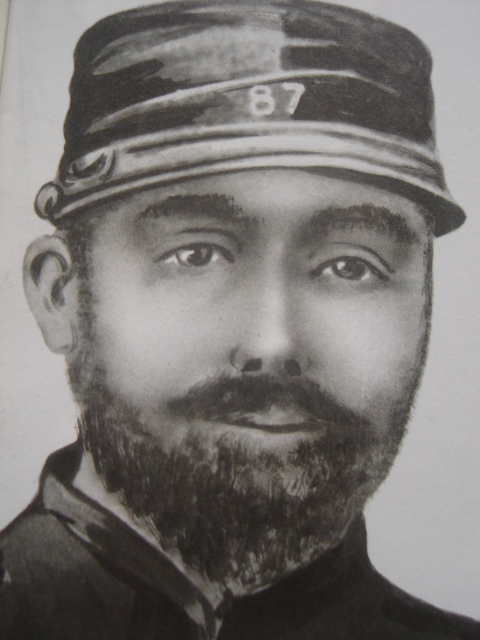
Henri Désiré Landru
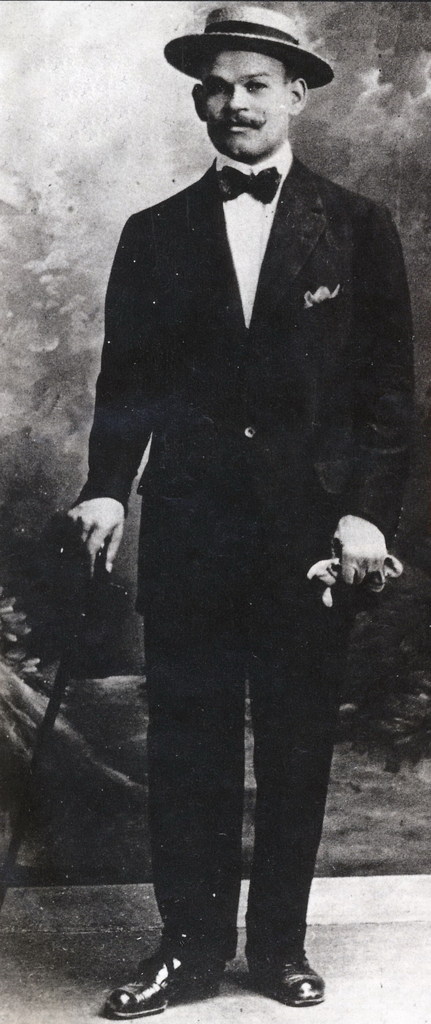
Henri Désiré Landru
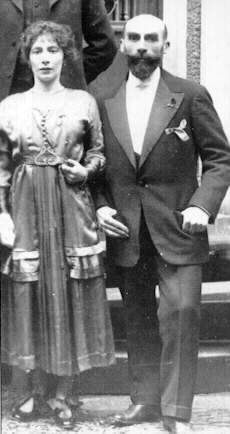
Henri Désiré Landru and Fernande Segret
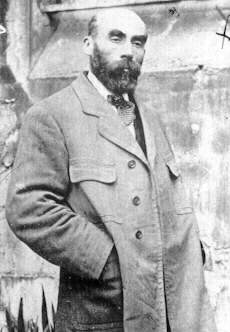
Henri Désiré Landru
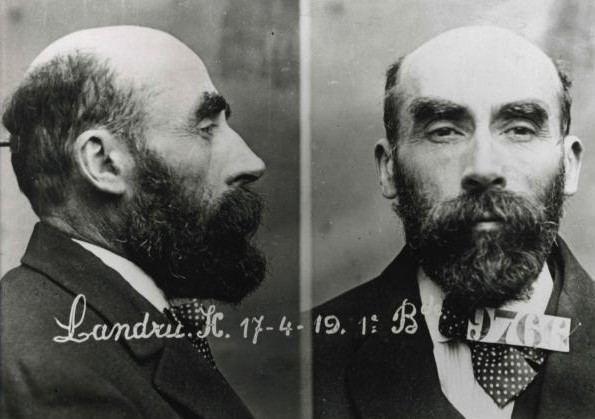
Henri Désiré Landru mugshot
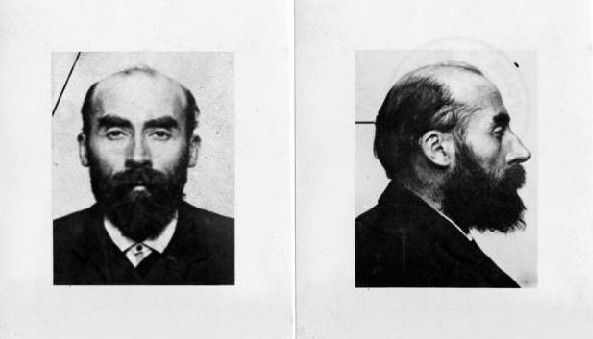
Henri Désiré Landru mugshot
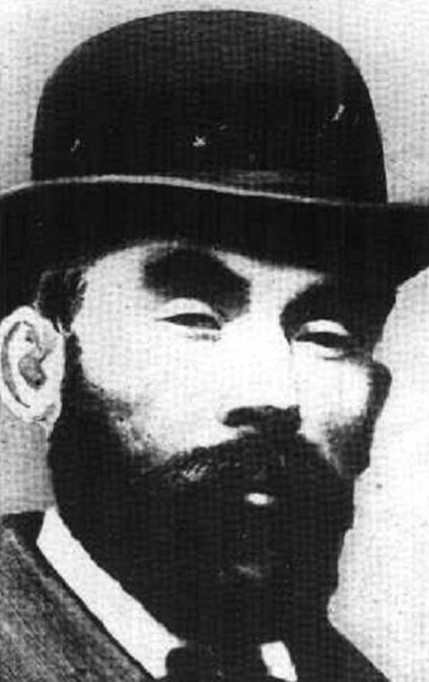
Henri Désiré Landru
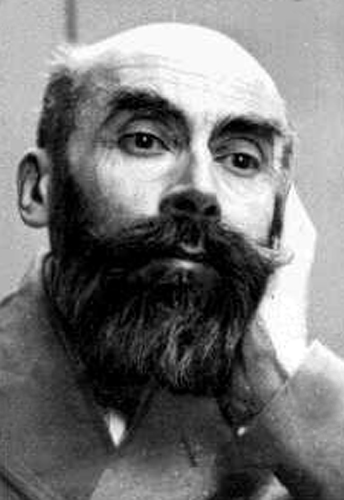
Henri Désiré Landru

Henri Désiré Landru
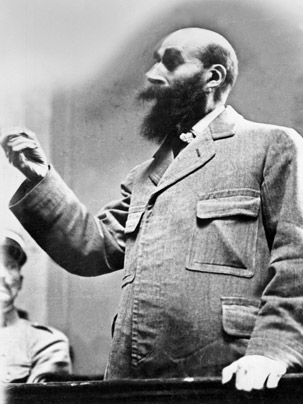
Henri Désiré Landru testifies at trial
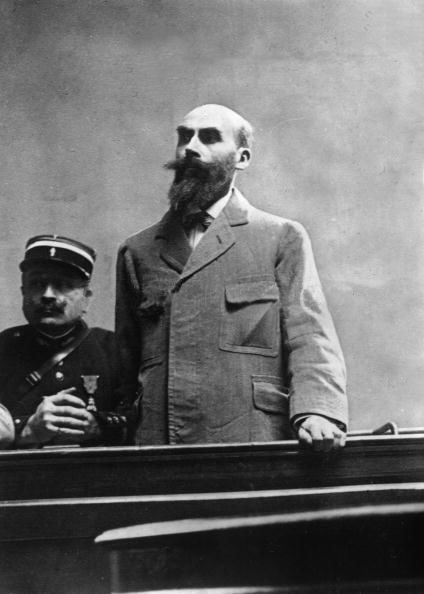
Henri Désiré Landru at trial

Henri Désiré Landru
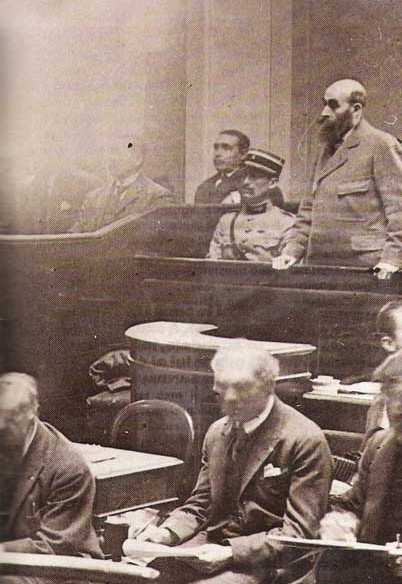
Henri Désiré Landru
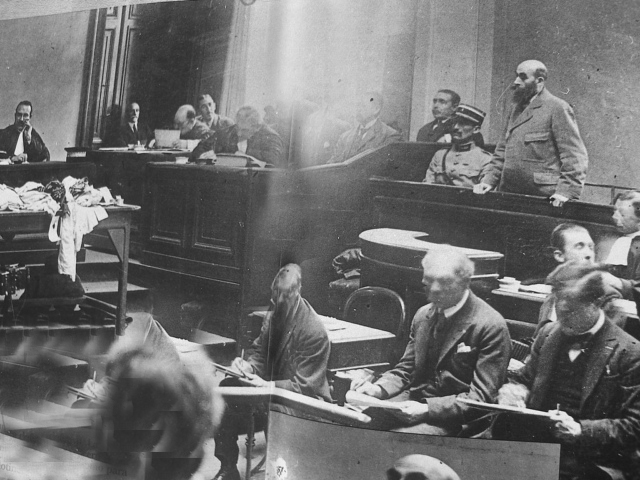
Henri Désiré Landru
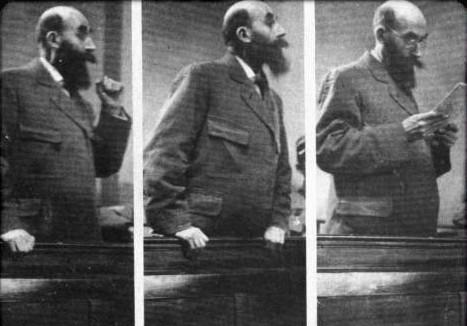
Henri Désiré Landru at trial
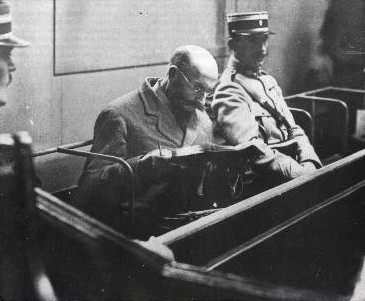
Henri Désiré Landru
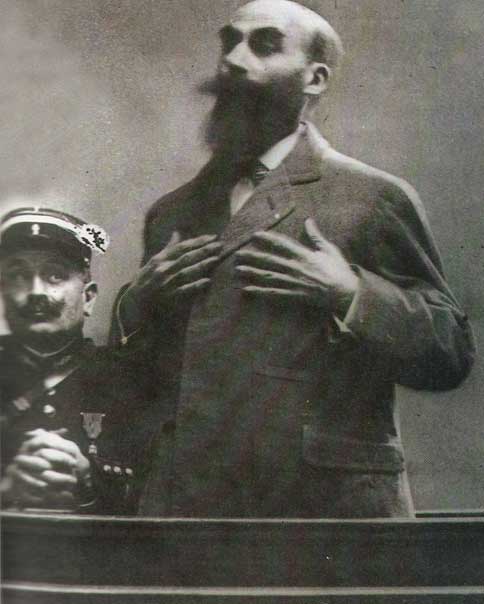
Henri Désiré Landru at trial
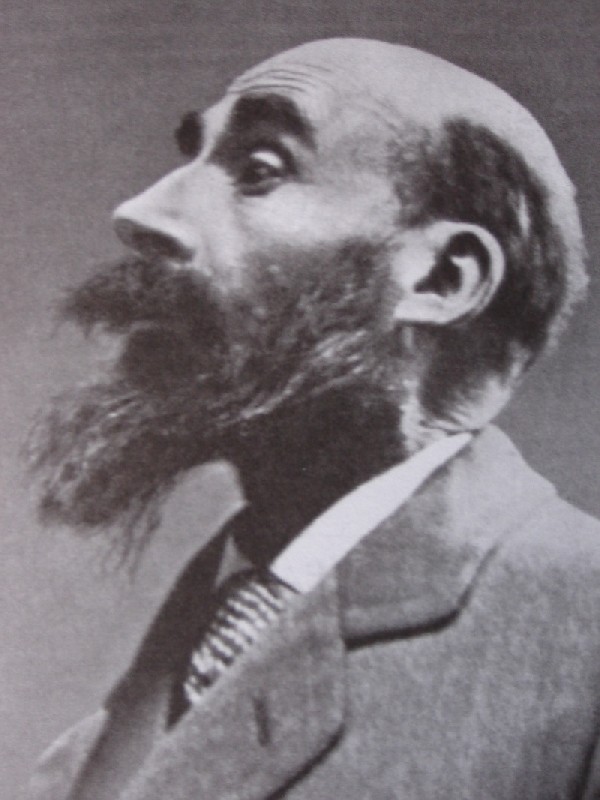
Henri Désiré Landru
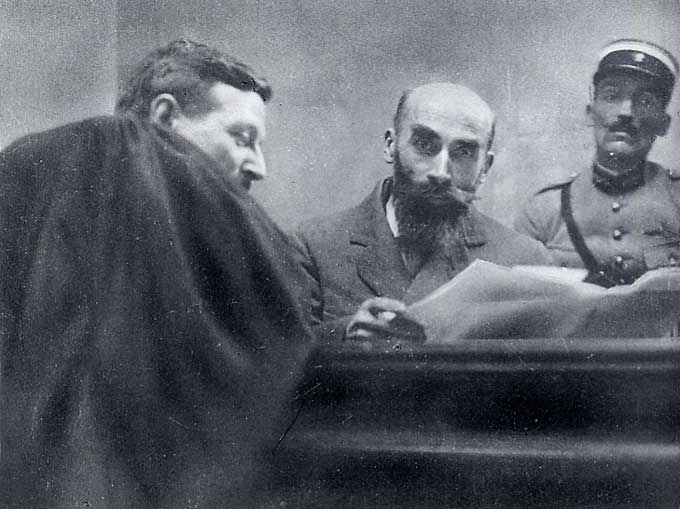
Henri Désiré Landru
Classification: Serial killer
Characteristics: Real-life "Bluebeard"
Number of victims: 11
Date of murders: 1915 - 1919
Date of arrest: April 12, 1919
Date of birth: April 12, 1869
Victims profile: Jeanne-Marie Cuchet, 39 / Andre Cuchet, 16 / Thérèse Laborde-Line, 47 / Marie Angélique Guillin, 51 / Berthe Anna Héon, 55 / Anne Collomb, 44 / Andrée-Anne Babelay, 19 / Célestine Buisson / Louise-Joséphine Jaume, 38 / Anne-Marie Pascal, 33 / Marie Thérèse Marchadier, 37
Method of murder: Strangulation?
Location: France
Status: Executed by guillotine in Versailles on February 25, 1922
Henri Désiré Landru (born April 12, 1869; died February 25, 1922) was a notorious French serial killer and real-life Bluebeard.
Early life
Landru was born in Paris. After leaving school, he spent four years in the French Army from 1887 – 1891. After he was discharged from service, he proceeded to have a sexual relationship with his cousin. She bore him a daughter, although Landru did not marry her; he married another woman two years later and had four children. He was shortly swindled out of money by a fraudulent employer. He turned to fraud himself, operating scams that usually involved swindling elderly widows. He was sentenced to two years imprisonment in 1900 after being arrested and found guilty of fraud, the first of several such convictions. By 1914, Landru was estranged from his wife and working as a second-hand furniture dealer.
Murders
Landru began to put advertisements in the lonely hearts sections in Paris newspapers, usually along the lines of "Widower with two children, aged 43, with comfortable income, serious and moving in good society, desires to meet widow with a view to matrimony." With World War I underway, many men were being killed in the trenches, leaving plenty of widows upon whom Landru could prey.
Landru would seduce the women who came to his Parisian villa and, after he was given access to their assets, he would kill them and burn their dismembered bodies in his oven. Between 1914 and 1918, Landru claimed 11 victims: 10 women plus the teenaged son of one of his victims. With no bodies, the victims were just listed as missing, and it was virtually impossible for the police to know what had happened to them as Landru used a wide variety of aliases in his schemes. His aliases were so numerous that he had to keep a ledger listing all the women with whom he corresponded and which particular identity he used for each woman.
In 1919, the sister of one of Landru's victims, Madame Buisson, attempted to track down her missing sibling. She did not know Landru's real name but she knew his appearance and where he lived, and she eventually persuaded the police to arrest him. Initially, Landru was charged only with embezzlement. He refused to talk to police, and with no bodies (police dug up his garden, but with no results), there was seemingly not enough evidence to charge him with murder. However, policemen did eventually find various bits of paperwork that listed the missing women, including Madame Buisson, and combining those with other documents, they finally built up enough evidence to charge him with murder.
List of victims
Madame Cuchet (last seen January 1915)
Son of Madame Cuchet (last seen January 1915)
Madame Laborde-Line (last seen 26 June 1915)
Madame Guillin (last seen 2 August 1915)
Madame Heon (last seen 8 December 1915)
Madame Collomb (last seen 25 December 1915)
Andree Babelay (last seen 12 April 1916)
Madame Buisson (last seen 19 August 1916)
Madame Jaume (last seen 25 November 1917)
Madame Pascal (last seen 5 April 1918)
Madame Marchadier (last seen 15 January 1919)
Trial and execution
Landru stood trial on 11 counts of murder in November 1921. He was convicted on all counts, sentenced to death, and guillotined three months later in Versailles. During his trial Landru traced a picture of his kitchen, including in it the stove in which he was accused of burning his victims. He gave this drawing to one of his lawyers, Auguste Navières du Treuil. In December 1967 the drawing was made public, written in pencil on the back Landru had written "Ce n'est pas le mur derrière lequel il se passe quelque chose, mais bien la cuisinière dans laquelle on a brûlé quelque chose" (It is not the wall behind which a thing takes place, but indeed the stove in which a thing has been burned). This has been interpreted as Landru's confession to his crimes.
In popular culture
Landru was the inspiration for Charlie Chaplin's film Monsieur Verdoux (1947). The original story was written by Orson Welles, who originally wanted to direct the film with Chaplin in the title role. However, since Chaplin did not like to be directed by anyone but himself, Chaplin bought the story from Welles. Chaplin then wrote, directed, and starred in Monsieur Verdoux himself.
The 1960 film, Bluebeard's Ten Honeymoons, starred George Sanders as Landru.
The 1962 film Landru, directed by Claude Chabrol, was inspired by the murders.
In the 1963 episode of The Twilight Zone entitled "The New Exhibit", a wax figure of Landru plays an important role.
The case also featured in one of the episodes of the 1976 BBC series Second Verdict.
A 2005 French movie named Désiré Landru is another adaptation of this story.
In 2001, the French satirical journalist Frédéric Pagès, writing under the pseudonym Jean-Baptiste Botul, published a book entitled Landru: Precursor of Feminism (Landru, Precurseur du Feminisme: La Correspondance Inedite, 1919-1922).
Accounts in English include Dennis Barden's The Ladykiller: The Life of Landru, the French Bluebeard and William Bolitho's Murder for Profit.
Henri Désiré Landru's severed head is on display at the Museum of Death in Hollywood, California.
HENRI LANDRU
The Legend of Bluebeard
ONCE UPON A TIME, there was a wealthy man who owned a grand estate. His home was filled with the finest riches and he himself was a grand specimen of man. But the man was cursed with a blue beard that made his visage so terrible that there was not a woman or a girl who upon seeing him would not flee with fright.
One of his neighbors, a widow, had two beautiful daughters. Bluebeard asked for the hand of one in marriage and left it up to the widow to choose.
Neither of the girls wanted to marry Bluebeard. One of the things that most frightened the young women was that Bluebeard had taken seven wives before this and no one knew what had happened to them.
To sway them, Bluebeard invited the family to his estate in the country so that they could come to know him and to love him. They remained in his home for a week and a day and everyone spent the visit in enjoyable pastimes.
Finally, Fatima, the younger and more beautiful of the two daughters, began to find that Bluebeard was not so terrifying. As soon as they returned to the city, Bluebeard and Fatima were wed.
Soon, Bluebeard told his wife that he had an important business trip. He suggested she leave the city and return to the country estate with her sister.
"Here," said Bluebeard, handing her keys to the estate. "This is the key to my safe, where I have stored my gold and my precious stones. And here is a key that opens every room in the estate.
"But this small key," Bluebeard said, his face suddenly turning stern, "is the key to the closet at the end of the basement. Open any room you wish, but do not venture into the basement and unlock that closet."
The husband drew his wife near to him, so close she could feel the bristles of his blue beard.
"If you should ever open it," he said. "Then you shall feel my wrath."
Fatima promised to obey this simple wish. They embraced, and Bluebeard left.
The dust from his carriage wheels was barely settled when, with the curiosity that comes with youth, Fatima took the key and rushed to the basement, determined to find what lay behind the closet door.
Seized with curiosity, she reached the basement and crossed to the imposing cabinet. It was not a piece of furniture in the usual sense, but was a door built into the stone wall of the cellar, thick as a tree trunk and sturdy as a bull.
Fatima stood there in front of the door for some time, thinking about the words her husband had left with her. But Fatima was too curious and the temptation that filled her head was stronger even than her fear of Bluebeard.
She took the small key and with trembling hand opened the door.
At first she could not see anything. But soon her eyes began to adjust to the dim light and she was able to see the contents of this terrible place. The room was like an abattoir; the floor was awash in curdled blood and in the blood lay the bodies of the seven wives of Bluebeard. Their throats had been cut from ear to ear.
Stunned, Fatima dropped the key into the blood on the floor. When she regained her senses, she recovered the key and quickly left the room, fleeing as though Bluebeard himself pursued her.
Fatima saw the key was stained with blood and tried to clean it. But the key was a magic key and it would not be cleansed. No matter how hard she wiped, the blood did not go away. She washed it in bleach, but the stains would not fade. She scrubbed it with the roughest brush from the kitchen, but still the blemish remained on the key. Even sandstone would not remove the horrible taint.
As the fates would have it, Bluebeard returned from his voyage that evening, having learned that his business affair had been resolved in his favor. With great joy he returned to his beautiful wife.
Fatima was pale with fear as Bluebeard entered their rooms and she shivered as he took her hands.
"Why do you tremble at my touch, madam?" the treacherous husband asked.
"My lord, it is not fear, but gladness," Fatima replied. "I have missed you so that my heart was filled with the cold of longing. But now that you are returned to me, I quiver with joy."
"I see," said the murderous Bluebeard. "And have you my keys?"
"Why yes, husband."
"I am going down to warm myself by the fire. Bring them to me there," said Bluebeard, leaving poor Fatima alone in her chamber.
In desperation, she hid the magic key in among her clothes and went to return the others to her husband.
"Tell me, my beloved. Why is the key to the basement cabinet not with the others?" He asked.
"My Lord, it must be there," poor Fatima avowed, knowing her words to be false.
"Wife! It is not here. Fetch it for me, now." Bluebeard's voice rose in anger.
Fatima left the hall and returned to her chambers, taking the key from whence she had hidden it.
"Why," he asked in a voice that chilled her to her bones. "Why is there blood on this key?"
"I do not know anything of it!" cried the girl, paler than death.
"You do not know anything of it," Bluebeard roared, taking his wife by the wrist. "But I know it well! You wanted to enter the cabinet. Well then, madam, you will enter there and take your place with the ladies that you saw there!"
Fatima threw herself at the feet of the perfidious Bluebeard and cried out for forgiveness. Her pleas should have softened a rock. But Bluebeard had a heart harder than stone.
"Give me a little time to make my peace with God, since it is necessary that I die," she begged.
"I give you a quarter hour, but no more," he said, leaving her in her chamber.
Fatima called to her sister, Anne.
"I pray you, go to the top of the tower, to see whether our brothers come; they promised to visit me, and if you see them, make signs to them to hasten," said poor Fatima.
Soon Bluebeard called her to come down to him and accept her fate.
"Anne, my sister, don't you see anything coming?" Fatima pleaded to her sister.
"I see," answered Anne, "two riders who are coming this way, but they are still far away."
"God be praised," wept Fatima. "They are my brothers. Tell them to hasten."
Now Bluebeard cried out in a voice loud enough to shake the entire house and Fatima was left with no other course but to go down to him. Outside the house, Fatima again threw herself to the ground.
"That does not serve you well, woman," growled the man as he pulled her up by her hair. "It is necessary that you die."
His hand came down to slice, but before the blade touched her alabaster throat, the gate to the chateau opened. Bluebeard saw two riders approaching with swords in hand. The coward recognized them as his wife's brothers and he dropped his wife and fled for his life. But the brothers continued to chase him and upon catching him, ran him through with their swords and left him for dead.
When they returned to their sister, she was near death, but with the help of their sister Anne, they revived fair Fatima.
It turned out that Bluebeard had no heirs, so his fortune was left to Fatima. She used some of it to make a dowry for her sister, Anne, who married a man she had loved for a long time. Fatima used another part to reward her brothers, and the rest she kept for herself.
Fatima later married a strong, good man, and in time, they filled the estate with children, the fiend Bluebeard was soon forgotten and they all lived happily ever after.
"La Barbe bleue"
Henri Desirè Landru
He was a little man, shorter than most, with a bald head and thick, brownish-red beard. His eyebrows were thick and bushy and arched above his dark eyes, giving the impression that he was always astonished or surprised.
By physical appearance, Henri Landru was not the type of man that one would suspect of being able to romance more than 300 women out of their life savings. But there was something special about this bourgeois second-hand furniture dealer and automobile mechanic that vulnerable women found irresistible.
And for 10 of them, their willingness to believe the lies Landru told them would cost them more than their meager fortunes -- the price they paid for falling under the spell of this 20th century Bluebeard was their life.
Born of parents of modest means in 1869 during the middle of France's 3rd Republic, Landru's childhood and early years were as nondescript as he was. His mother was a housewife and his father was employed as a fireman in the furnaces of Paris' Vulcain Ironworks.
Young Henri was considered a bright lad who attended Catholic school and was admitted as a sub-deacon in the religious order of St. Louis en l'Isle. His schooling ended, like many boys of that era, around his 17th year after he took courses in engineering at the prestigious School of Mechanical Engineering.
Drafted by the military at 18, Landru excelled in the armed forces, reaching the rank of sergeant by the time of his discharge four years later.
Clearly by his teen years Landru had realized that he was cleverer than most and was glib with the ladies. In 1891, he seduced his cousin, Mademoiselle Remy, who became pregnant and bore him a daughter. Two years later Landru married Mme. Remy, while he was quartermaster of the regiment at St. Quentin. Upon their marriage, Landru left military life and went into business as a clerk.
His employer, however, was unscrupulous and absconded with the money Landru had given him as a bond, leaving a strong impression on Henri. Incensed with this blow which fate had dealt, Landru apparently made a vow to get “revenge” through a life of crime.
Despite his standing as a deacon and member of the choir of his church, Landru became a swindler in addition to his legitimate businesses as furniture dealer and garage owner. His targets were most often the middle-aged widows whom he would meet through the furniture business.
Used to following the direction of their husbands and faced with the prospect of long, lonely, poverty-stricken lives, these women would come to him to sell their possessions. Landru would prey on their fears and in addition to taking their possessions, would woo his victims and entice them to let him invest their meager pensions, which he would promptly steal.
The scam worked well for some time, until 1900, when Landru made his first appearance in a French courtroom as a criminal. He was sentenced to a two-year prison term for fraud after he tried to withdraw funds from the Comptoir d'Escompte using a fake identity. Upon his arrest Landru attempted (some say pretended to attempt) suicide in jail.
He remained married to Mme. Remy and together they had four children.
For the next decade, Landru was in and out of prison seven times (apparently the 3rd Republic had no "three strikes" laws) serving as much as three years at a time. Sometime around 1908, he apparently struck upon the scheme that would eventually bring him face-to-face with the guillotine.
In that year, Landru, already serving a sentence in a Parisian prison for fraud, was brought to Lille to stand trial for another scam. He had placed a matrimonial advertisement in a newspaper, portraying himself as a well-to-do widower seeking the companionship of a similarly situated widow.
In return for some counterfeit deeds, Landru persuaded a 40-year-old widow to part with a 15,000-franc dowry. Mme. Izore was left destitute and sought recompense through the courts. She would have to content herself with the knowledge that Landru would serve an additional three years for by the time the gendarmerie caught up with Landru the dowry was gone.
He was released shortly before World War I, most likely with the understanding that he would re-enlist in the French Army. He had already driven his father to suicide over his lawlessness and left his family penniless and humiliated. Landru's mother had died in 1910. He drifted around the countryside, well aware of the fact that he had been convicted in absentia for various other offenses and sentenced to lifelong deportation to New Caledonia.
A Unique Killer
Once the war started, Landru, who was still married to but estranged from Remy, began the scams that lead to his downfall. Perhaps it was the war with its heretofore-unknown measure of death that turned Landru into a murderer; perhaps it was the years spent in undoubtedly harsh French prisons, or perhaps it was something else.
The Earl of Birkenhead, eminent Oxford don and author of Famous Trials of History, discounts the theory that Landru was driven by bloodlust to kill his female suitors. "There seems to be no evidence of that," he writes in the marvelous 1929 follow-up to Famous Trials. "A man who embarks on this kind of adventure must shake himself free of entanglement...It is therefore inevitable that a proportion of the women would be difficult to shake off and some must have shown no great disposition to hand over their property.
"The obvious means of overcoming their attachment," Birkenhead surmises, "was to destroy them, and to do so was only too easy...We must therefore postulate that he was callous and inhuman -- an assumption which offers no difficulty, seeing that his very mode of life was impossible for any other kind of man."
Well-known criminologist Colin Wilson calls Landru "a callous ruffian who deserved to be guillotined;" the entry in Wilson's Encyclopedia of Murder recounts the savoir-faire that made Landru attractive to his victims. His sense of humor and strong will certainly came out during his detention, interrogation and at his trial.
Perrault's fairy tale about the blue bearded monster that kills his wives but is done in by a young woman's curiosity is a well-recounted story. Not only does it exist in French literature, but in African, Spanish and Chinese legend as well. If ever a serial killer resembled a mythic figure, it was Henri Landru as Bluebeard.
There is not a lot known about Landru, but by his actions, it is possible to develop a simple profile of this modern Bluebeard. His victims, both the living and the dead, were among the more vulnerable members of society, so he was clearly without conscience (few serial murderers are ever stricken by remorse or guilt for their actions, except to say that they are sorry to have been captured). There were so many victims of his confidence schemes -- the contemporary estimates numbered about 300 -- that he was clearly greedy.
He was probably a romantic man, able to sweep lonely women off their feet, and since his physical appearance was more comical than handsome, he must have been a smooth, fast-talker. His sexual appetite reportedly was ravenous.
Landru was intelligent and silver-tongued, not only with the ladies, but also with his fellow soldiers and other men. All the while he was taking advantage of women, Landru was also defrauding weary recently discharged soldiers of their pensions.
Landru was not a simple psychopath like other serial murderers. He had a sense of right and wrong, but did not apply the same rules to himself. He justified conning one soldier out of his detachment pay because the man had a mistress, despite the fact that Landru also had a mistress and was cheating on her as well as on his wife. He showed a sense of remorse over some of his actions -- not his homicides -- expressing embarrassment in court that his wife, the long-suffering Remy, would find out that he had been cheating on her because of certain testimony!
Putting a label on Henri Landru is difficult because he does not really fit into a specific crime classification. At best he can be called a multiple murderer, rather than a serial or spree killer.
He cannot really be considered a serial killer, because serial killers are currently defined as persons who kill three or more victims, in different locales and in either an organized or disorganized fashion, with some sort of cooling off period between the killings. Most often the killings are the culmination of a build-up of anger or lust, and the murderer finds a sense of release after the slaying. They have a great deal of control over their victim selection and time of the crimes, and their identities are not usually known until the time of arrest. Landru meets some of these criteria, but the time gaps between slayings was caused by his need to get close to his victims in order to obtain financial reward. If sex or anger was at the root of his murderous need, Landru could easily have killed his victims shortly after he got to know them. Or better yet, his selection of victims would have been more random.
Spree murderers, on the other hand, are killers whose crimes take place in different locales, in a disorganized fashion, but within a fairly short period of time. Often, spree killers are not in control of victim selection or the time of killing. They are usually on the run from at least the first offense (often before). Law enforcement agencies often know the identity of a spree killer before arrest. Henri Landru was in control of his victim selection and in the time of their deaths. He was not pressured into a "hurry-up" situation by law enforcement pursuit and never appeared to be on the lam despite his conviction in absentia.
Landru killed for money or to rid himself of a tiresome or inconvenient lover. His method of killing is unknown, but evidence at his villa suggests that the slayings were most likely clean, and that the victims were probably not defiled in any way. It is possible that Landru killed during a sex act, but there is no evidence that suggests this was the case. Lust was not his primary motive, and he is distinctive among multiple murderers because anger, revenge or sexual release were at best secondary motivators.
Most killers for financial gain do not destroy the evidence of their victims' deaths. In insurance or inheritance scams, proof of death is often required -- few killers want to wait a decade or so to collect their ill-gotten reward. But Landru obviously took great pains to cover up his crimes. He sought to avoid detection and make it look like his victims were still alive.
In effect, Landru created a different classification of multiple killer; he was the male version of a Black Widow spider, one that takes what it needs and then kills its mate without remorse. Henri Landru combined the worst characteristics of the most terrible type of criminal.
Bluebeard's "Wives"
In 1914, the following advertisement appeared in the Paris newspapers: "Widower with two children, aged 43, with comfortable income, serious and moving in good society, desires to meet widow with a view to matrimony."
For a French widow, faced with a life of loneliness and penury in the depressed economy of wartime France, such an advertisement must have seemed as heaven-sent. Landru, who placed the ad, had no trouble meeting women.
The first woman to meet this 20th Century Bluebeard was Madame Cuchet, a 39-year-old woman with a 16-year-old son, Andre. Cuchet worked in a lingerie shop in Paris and was barely keeping her head above water when she made Landru's acquaintance. He told her his name was Monsieur Diard and that he was an engineer. Their relationship flourished over time but was not without its ups-and-downs.
Landru's scheme was almost revealed before it had a chance to flower after Cuchet and "Diard" had a falling-out. Cuchet begged her family and brother-in-law to accompany her to Diard's villa near Chantilly, with the hopes of ironing out their differences. Landru was not in when they arrived, but the family apparently felt enough at home to search the villa.
Her brother-in-law found a chest filled with many letters from other women, and informed Cuchet that her lover was a fraud. She chose to disregard her family's advice to dump the imposter, and instead furnished a villa at Vernouillet, outside Paris and became estranged from her family. Diard, Cuchet and her son moved to the villa.
The last time Cuchet and Andre were seen alive was in January 1915. Shortly after the three moved into Vernouillet, Landru opened a bank account with 5,000 francs, which he claimed was part of his inheritance from his father. In all likelihood the money came from Cuchet. Soon after Cuchet's disappearance, Landru's wife was presented with Cuchet's watch as a present.
His next victim was an Argentine named Madame Laborde-Line, the widow of a hotelier. She had told friends that she was planning to marry a charming engineer from Brazil, but frustrated with the red tape, the pair decided to dispense with the ceremony and move in together.
Afterward, a man that her former neighbors identified as Landru came back and collected her furniture, sending some to his villa and the rest to a garage in Niuelly. Laborde-Line was last seen in July 1915, when she had arrived at the villa with her two dogs.
Madame Guillin, a 51-year-old widow whose full name was Marie Angelique Desiree Pelletier was last seen at the villa a month later. Also in 1915, a Madame Heon, visited Vernouillet and disappeared.
Whether or not there were others between the murders of Heon and 19-year-old Andree Babelay, a servant girl who disappeared in March 1917 en route to visiting her mother, only history knows. And why Babelay was slain is also a mystery. She was as poor as a church mouse and had nothing to give Landru but her charms. Did she, like Fatima in the legend of Bluebeard, stumble across Landru's secret, or was she killed merely because he could not rid himself of her? Regardless, poor Babelay followed the fate of Landru's other victims and was never seen alive again after meeting up with Landru.
After Babelay disappeared, Landru, apparently busy with other scams like his detached soldier scam and a petrol fraud, left Vernouillet for a new villa in Gambais and promptly had a large cast-iron oven installed. He laid low for almost two years, but soon returned to his murderous ways.
Landru courted Madame Buisson, a wealthy widow, for nearly a year before he succeeded in creating an estrangement from her family. She moved with him to Gambais, without her son, who went to live with his aunt. In April 1917, Buisson was seen for the last time.
His next victim at Gambais was Mme. Louise Leopoldine Jaume, who disappeared in September 1917. After her disappearance, Landru's new neighbors in Gambais noticed black, noxious smoke pouring from his villa.
Annette Pascal, 38, followed Jaume by vanishing in the spring of 1918, and finally, Marie Therese Marchadier, an "entertainer" known among the non-commissioned officers of French Army as "La Belle Mythese" and who had retired to relative anonymity in Paris, was visited by Landru who wanted to purchase her furniture. A friendship blossomed and she accompanied the murderer to Gambais in late 1918 and promptly disappeared.
In all, at least 10 women and one boy (and two dogs) had disappeared after meeting Landru, yet no police had ever suspected him of any misdeeds. It would take a pair of anxious families to bring Bluebeard at long last to justice.
The Arrest and Investigation of Landru
Landru had taken great pains to separate his victims from their families, but after their deaths, he took equally strong measures to assure the families that their loved ones were alive and well.
Two of Guillin's friends received postcards from Landru, saying that Guillin was unable to write herself. He forged a letter from Buisson to her dressmaker and another to the concierge of her Paris apartment. Landru represented himself as the attorney of Madame Jaume, who was divorcing her husband, and successfully closed out her bank accounts.
Two years after Buisson met Landru, her son, who was living with her sister, passed away. Obviously the family wanted to notify Mme. Buisson, but was unable to find her. Her sister remembered that Buisson had whispered her intention of running away to Gambais with a "Monsieur Guillet."
She wrote to the mayor of Gambais, seeking help in locating either Buisson or Guillet. The mayor replied that he knew of neither of them, but perhaps she should meet the family of a Madame Collomb, who was also missing in Gambais. She had vanished under similar circumstances.
Unbeknownst to anyone, Collomb had disappeared after meeting Landru in early 1917.
The tenant of the villa in question, the mayor told the family of Buisson was not Monsieur Fremiet, the fiancé of Buisson, but M. Dupont. However, when the police went to Villa Ermitage, as Landru's estate was known, they could not find Fremiet, Dupont, Diard (the name given to Collomb's family) or Landru. The villa was unoccupied but recently lived-in.
Mademoiselle Lacoste, Buisson's sister, was not discouraged. She had seen "Fremiet" so she began combing the streets of Paris near Fremiet's old residence looking for him. In 1919, her search paid off. She spotted Landru coming out of a dry goods shop and followed him, only to lose him in the crowd.
She returned to the store and found out that the man's name was not Fremiet, but Guillet, and that he lived in the Rue de Rochechouart with his mistress. Immediately, the police were summoned and Landru was arrested.
But on what charge should he be held, the gendarmerie wondered? Clearly murder was suspected, but where was the body? There was no evidence that Landru had killed anyone and the strong-willed “Bluebeard” was unwilling to discuss anything with authorities.
They returned to Gambais, where a thorough search was undertaken. The gardens were excavated looking for bones, but the only remains police found were those of a pair of dogs. They searched his old villa at Vernouillet and came up equally empty. All the police had to go on was a cryptic memorandum book where Landru had meticulously recorded his income and expenses.
But within the copious notes were several names that interested authorities. On one page was the entry: "A Cuchet, G. Cuchet, Bresil, Crozatier, Havre. Ct. Buisson, A. Collomb, Andree Babelay, M. Louis (sic) Jaume, A. Pascal, M. Thr. Mercadier." Buisson and Collomb were missing and the authorities soon learned that the whereabouts of the Cuchets were also in question. They suspected this was a list of victims. But again, they had no bodies.
Confident in the erroneous knowledge that he could not be convicted of murder without a body (such a conviction is possible under French law), Landru kept silent and refused to talk with police. For two years, authorities investigated the disappearances of his victims, yet Landru never admitted anything.
Slowly, they learned that each of the women in the ledger had met Landru through his marriage advertisements and had disappeared. Interestingly, Landru had recorded the purchase of one-way tickets from Paris to Gambais for each of his victims, while marking round-trip tickets for himself.
The gardens in Gambais and Vernouillet were dug up time and time again. Authorities tried to link Landru to purchases of acids and other chemicals, to no avail. Finally, neighbors at Gambais told authorities of the noxious fumes that often emanated from the kitchen. The stove that Landru had installed shortly after his arrival in Gambais was inspected and horrific evidence of murder was uncovered.
In the ashes police found small bones, undoubtedly human, as well as burned, but still recognizable fasteners of the kind worn on the clothes of French women. Landru had disposed of his victims by burning their remains. How they were killed was still a mystery, but what had happened to M. Collomb and M. Buisson, as well as the nine others, was clear.
Two years after his arrest, Landru was charged with 11 counts of murder and set for trial.
The Trial of Landru
There is little doubt that Landru's trial captivated his countrymen. Consider the time it occurred. He was arrested in April 1919 at his home in Paris with his mistress, 27-year-old Fernande Segret, whom he had picked up on an autobus in the city. France was still recovering from the bloodiest war in the history of civilization and the peace talks at Versailles were not going well for them.
Shortages and economic depression abounded and a case that promised sex, gossip and gruesome killing was delightfully played up by the papers as a diversion from the dreary day-to-day life of post-war France.
Also, take into account that in 1919 there was no such term as "serial killer." Although multiple murder wasn’t unknown in Europe, it was still a novelty (unlike present day, when the concept of a serial killer is as ubiquitous as a pickpocket was in the 19th century).
The murders committed by Jack the Ripper across the English Channel were just 40 years prior and a human monster who could kill so many without remorse was still an aberrance to the French and English alike. The idea that a Frenchman, a Parisian no less, could be capable of such atrocities had a profound impact on the society.
Landru's trial began in November 1921 and lasted nearly a month.
The French system of justice had been instituted in 1848 and while not, as is commonly believed, assuming the guilt of the accused until innocence is proven, it is heavily weighted against the person on trial. Not only does the chief judge of the three-judge panel serve as an interrogator, the French allow questioning of the accused for the sake of investigation in front of the jury during the trial.
The French system also allows relatives of the victim to bring suit for damages during the course of the trial, and the victims' legal counsel can question the accused and argue before the jury.
Clinging to his mistaken belief that he could not be convicted without evidence of a body, Landru's defense was essentially to stonewall the court. Time after time he would refuse to answer questions and would reply that it was no one else's business what he knew of their disappearances.
He also believed that because he had been judged sane enough to stand trial, his innocence was assured.
"In acknowledging I am sane, they are thus establishing my innocence," he told the media, which covered the trial with an enthusiasm unmatched for the time.
For days he stood before withering interrogation by the court without changing his story.
"I have nothing to say," he said over and over, much to the frustration of observers. Every time new evidence was unearthed, Landru merely shrugged his shoulders and denied everything or refused to discuss it.
"What of your relationship with Madam Guillin?" he was asked in open court.
"I am a gallant man and will say nothing," Landru replied to the exasperated magistrate. "I cannot think of revealing the nature of my relations with Madam Guillin without the lady's permission."
During the course of the trial Landru's health began to fail. He began to provide statements of fact in response to questions, but the prosecution easily refuted his allegations. His strategy was a tactical blunder, wrote Lord Birkenhead. "Where explanations are obviously needed," he wrote, "unless an unfavourable inference is to be drawn, the failure to afford these explanations...will tend to confirm the inference."
Landru's impudence before the court clearly grated on the jury. His evasions and quickness to answer with sarcasm only succeeded in proving that he was the kind of man who would deceive women like his victims.
It took the jury just two hours - after nearly 25 days of testimony - to decide Landru had killed the 11 women. The penalty for such a crime was death.
Bluebeard Meets Madame Guillotine
French justice is swift. Just two months passed from the time of his conviction until Landru received word that his execution was imminent. Unlike American justice, where a prisoner is well aware of his or her execution date, the French system does not inform the condemned until very shortly before the execution.
The guillotine is a curious method of execution and although it is generally held to be humane, there is some question about how quickly one dies after being decapitated.
Two doctors in the 1960s wrote that “death is not instantaneous. Every vital element survives decapitation...it is a savage vivisection followed by premature burial." Drs. Piedlievre and Fournier go on to discuss how the brain is capable of breaking down complex sugars in the neurons into oxygen for as long as six minutes after decapitation.
Eyewitness accounts also call into question the swiftness of the onset of death after beheading. "Did it, those who saw the grimacing heads in the basket wondered, kill instantaneously?" writes Colin Wilson. "In the 1790's this question was much debated, as when Charlotte Corday's head was held up and slapped by the assistant executioner, men swore that it not only blushed but 'showed most unequivocal signs of indignation.'"
In an even more graphic account written in 1905, a French doctor experimented with the head of an executed criminal:
"The head fell on the severed surface of the neck ... I was not obliged even to touch it in order to set it upright. Chance served me well for the observation, which I wished to make.
"Here, then, is what I was able to note immediately after the decapitation: the eyelids and lips of the guillotined man worked in irregularly rhythmic contractions for about five or six seconds. This phenomenon has been remarked by all those finding themselves in the same conditions as myself for observing what happens after the severing of the neck...
"I waited for several seconds. The spasmodic movements ceased. The face relaxed, the lids half closed on the eyeballs, leaving only the white of the conjunctiva visible. ... It was then that I called in a strong, sharp voice: "Languille!" I saw the eyelids slowly lift up, without any spasmodic contractions -- I insist advisedly on this peculiarity -- but with an even movement, quite distinct and normal, such as happens in everyday life, with people awakened or torn from their thoughts.
"Next Languille's eyes very definitely fixed themselves on mine and the pupils focused themselves. I was not, then, dealing with the sort of vague dull look without any expression, that can be observed any day in dying people to whom one speaks: I was dealing with undeniably living eyes which were looking at me.
"After several seconds, the eyelids closed again, slowly and evenly, and the head took on the same appearance as it had had before I called out.
"It was at that point that I called out again and, once more, without any spasm, slowly, the eyelids lifted and undeniably living eyes fixed themselves on mine with perhaps even more penetration than the first time. There was a further closing of the eyelids, but now less complete. I attempted the effect of a third call; there was one further movement -- and the eyes took on the glazed look which they have in the dead.
"I have just recounted to you with rigorous exactness what I was able to observe. The whole thing had lasted twenty-five to thirty seconds."
Regardless, in February 1922, Landru was brought before the guillotine.
Landru bade farewell to his attorneys and presented them with some artwork he had drawn while in prison. Had they looked inside the frame, his attorneys would have found a written confession from Landru admitting his crimes and the means by which he disposed of the bodies, but this was not discovered until nearly five decades later. He declined to hear a Mass and rejected the traditional glass of brandy from his jailer. Landru indignantly refused to make a statement, saying the very question was an insult.
Landru stood before the guillotine, which had been the preferred form of execution in France since its revolution a little over a century before. He knelt down and within moments, the blade had fallen and one of the coldest mass murderers of all time died without ever expressing remorse for his crimes.
Bibliography
Birkenhead, Frederick Edwin Smith, More Famous Trials. Garden City, N.Y.: The Sundial Press 1929.
Crimes and Punishment: A Pictorial Encyclopedia of Aberrant Behavior. The Symphonette Press, 1973.
Gaute, J.H.H. and Odell, Robin, The Murderers’ Who’s Who. New York: Methuen, Inc. 1979.
Wilson, Colin and Patricia Pitman, Encyclopaedia of Murder. London: A. Barker. 1961.
Henri Désiré Landru

Henri Désiré Landru

Henri Désiré Landru and Fernande Segret

Henri Désiré Landru

Henri Désiré Landru mugshot
Henri Désiré Landru mugshot

Henri Désiré Landru

Henri Désiré Landru

Henri Désiré Landru

Henri Désiré Landru testifies at trial

Henri Désiré Landru at trial

Henri Désiré Landru

Henri Désiré Landru
Henri Désiré Landru

Henri Désiré Landru at trial

Henri Désiré Landru

Henri Désiré Landru at trial

Henri Désiré Landru

Henri Désiré Landru


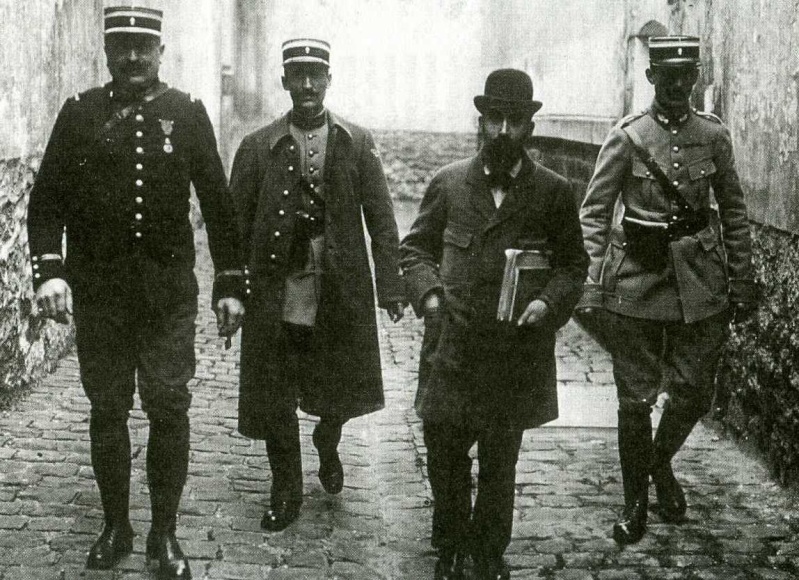
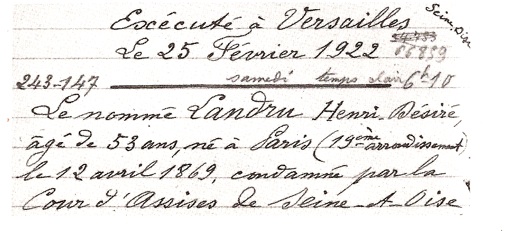


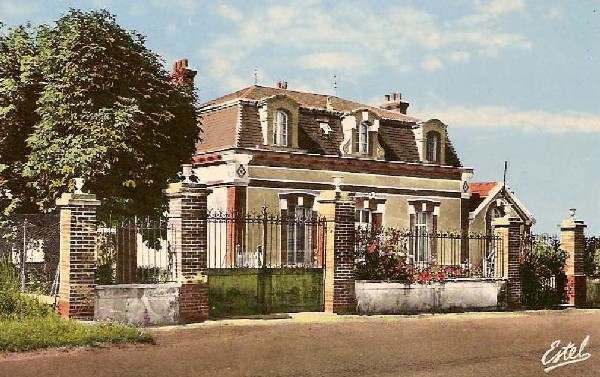

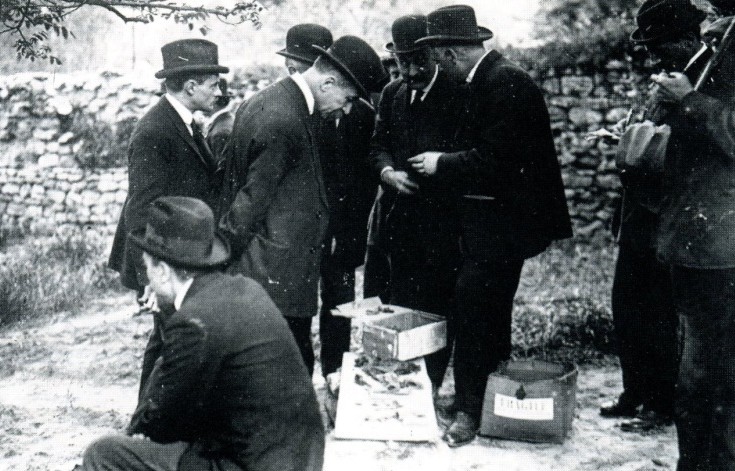
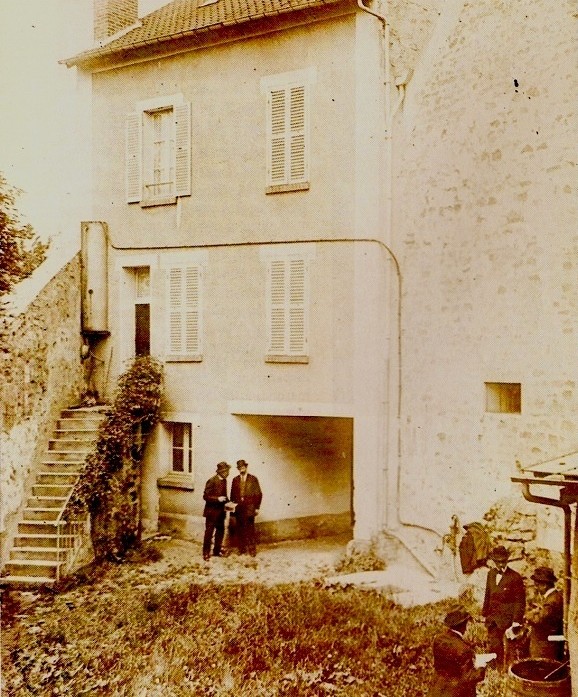
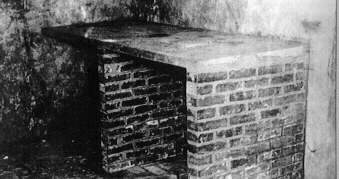
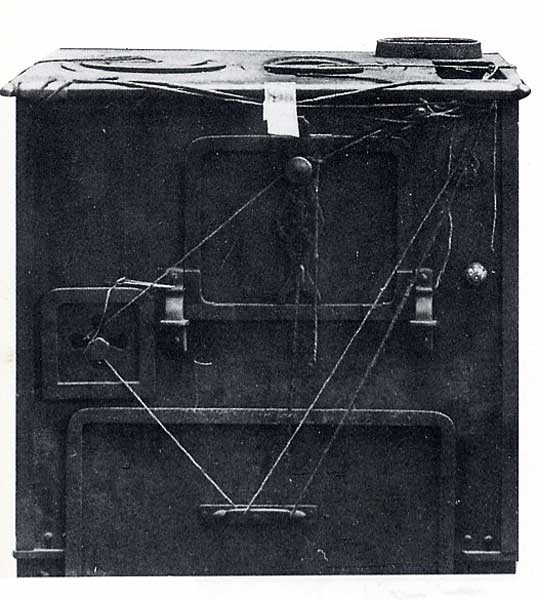
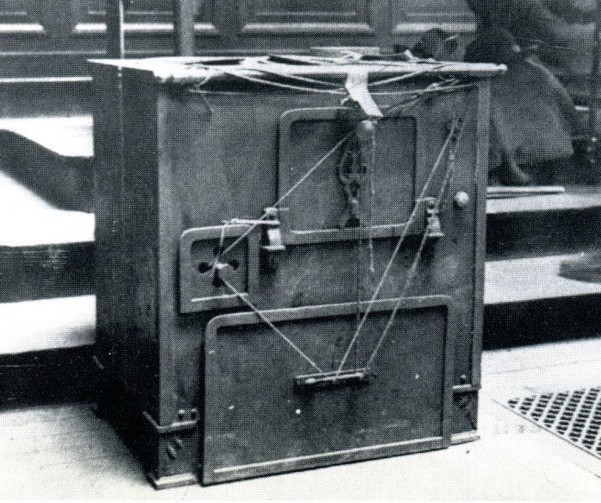
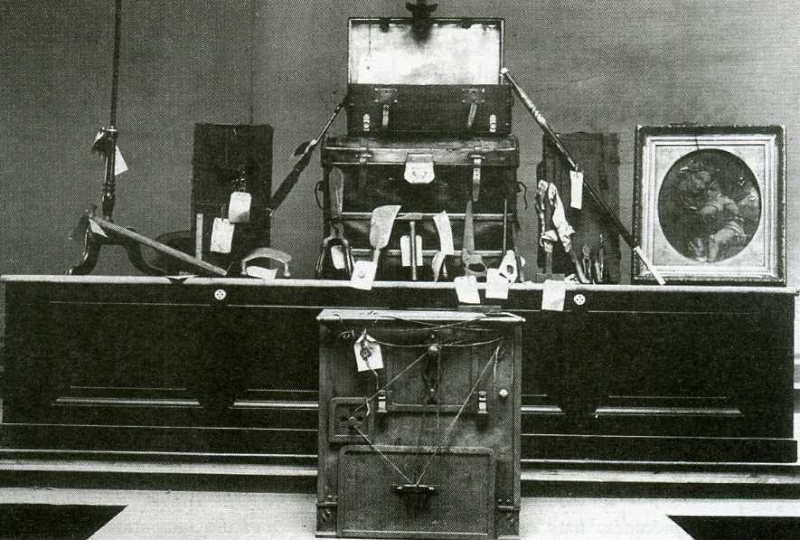

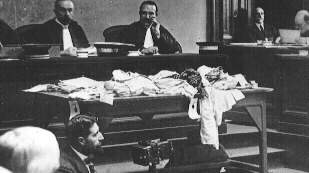

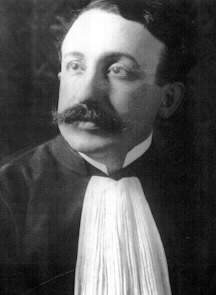
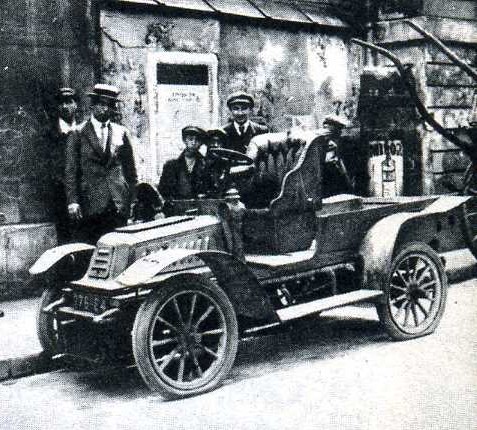
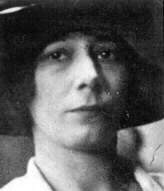
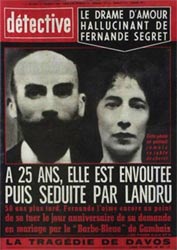
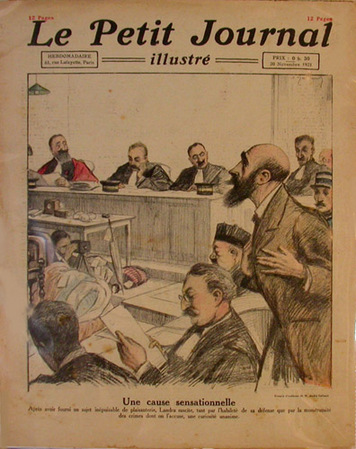



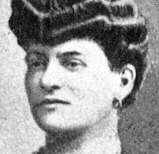

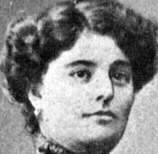
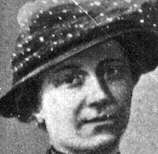

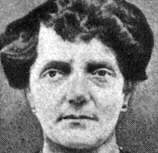
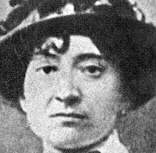

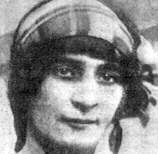
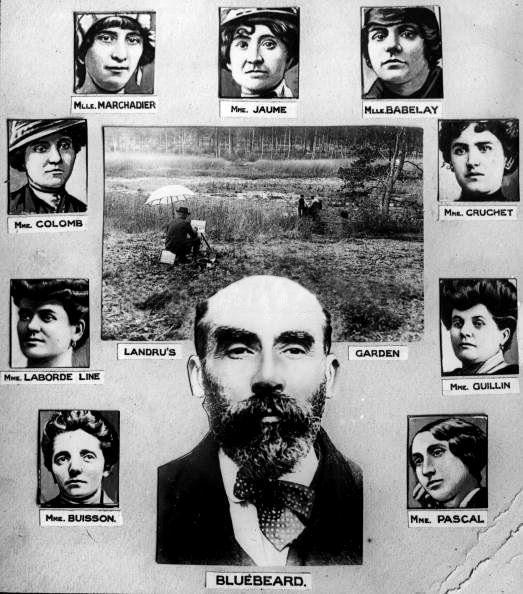
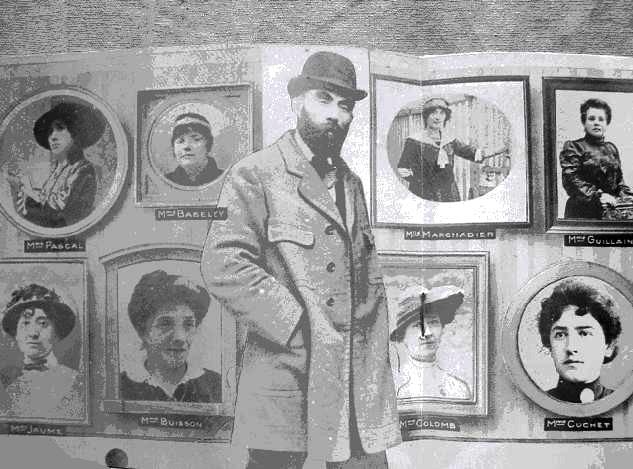
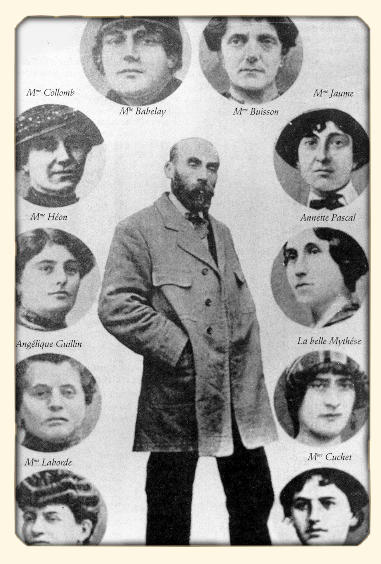

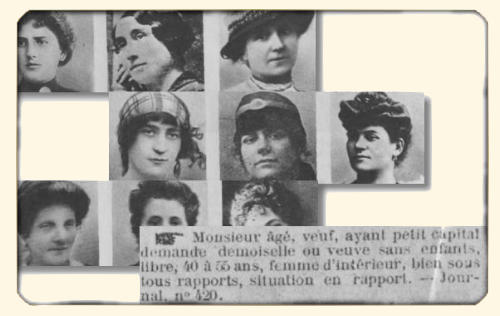
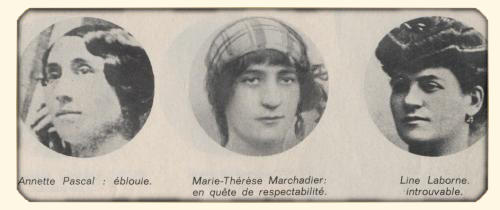

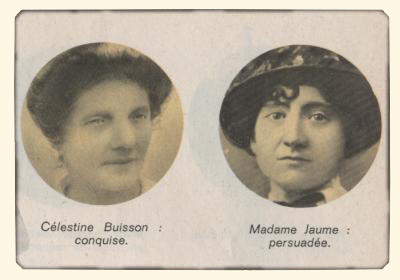
 Fuckin hell mike lol,how long does it take you to put these great reports on here
Fuckin hell mike lol,how long does it take you to put these great reports on here

